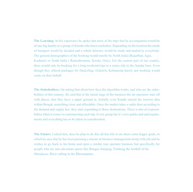RE-BRANDING DOOARS REGION - WEST BENGAL
West Bengal is a treasure trove of top-tier destinations, offering a rich cultural history, heritage, stunning beaches, majestic mountains, and diverse flora and fauna, making it a magnet for travelers worldwide. However, despite its unique appeal, the Dooars region, located in the Darjeeling districts of West Bengal, suffered from inadequate marketing strategies and promotion. Recognizing this, I developed a comprehensive business model to rebrand the region for the government, aiming to enhance its positioning and unlock its true potential as a prime vacation destination.
Service
Business Design
Client
WEST BENGAL X UAL
Year
2021

REFERENCE/INSPIRATION BOARD






RESEARCH QUESTION
How can the challenges of sustainable tourism development in the Dooars region, a prominent tea plantation area in Darjeeling, West Bengal, be addressed to integrate it into India's holistic tourism map?



PROBLEM STATEMENT
What strategic framework can effectively align the interests of the tourism industry and government to foster sustainable tourism development while establishing efficient community-based ventures in the Dooars region?
PROJECT OBJECTIVES
- Conduct an in-depth investigation of destination marketing strategies implemented by successfully developed countries, focusing on sustainable tourism practices. Analyze the key elements that contributed to their success, such as branding, community engagement.
- Assess the existing disconnect between governmental initiatives and the involvement of local communities in the tourism development process. Identify the underlying causes of these gaps, such as communication barriers, policy misalignment, or lack of resource access.
- Develop a comprehensive positioning strategy for the Dooars region that leverages its rich biodiversity as a core attraction. Recommend innovative experience design modules that integrate conservation, cultural heritage.
- Break down the roles and responsibilities of key stakeholders in the tourism ecosystem, including government bodies, private sector players, local communities, and tourists.

UNDERSTANDING TOURISM TRENDS

Describe your image

Describe your image

Describe your image

Describe your image
CASE STUDY REFERENCE

The Slovenian Tourism Board is imposing the ambitious Slovenia Green programmed to improve the competitiveness of local destinations. Under the green scheme, the tourism board has been enforcing the European Tourism Indicator system (ETIS) given that 2015 and uses the requirements of the worldwide Sustainable Tourism Council (GSTC) to set up a holistic certification scheme that takes below consideration Slovenia’s national developments on the extent of destinations and tourism organizations.
Every destination that wants to get hold of the Slovenia Green label is needed to signal improvement coverage as a signal of reliable dedication, and carry perform a 7-step method which includes raising consciousness, creating a holiday spot profile, and gathering statistical information. Once certified, vacation spot coordinators need to publish annual development reviews and enter a re-evaluation phase each to three years. In step with the extent of sustainability that can be confirmed, destinations can upgrade bronze to platinum in their certification. These obligations have ensured a constant growth of traveller inflows that commensurate with efforts to enhance sporting potential.
RESEARCH GAP: INDIA OVERVIEW

Describe your image

Describe your image


Describe your image

STAKEHOLDER INTERVIEWS


SWOT ANALYSIS + TARGET AUDIENCE + CUSTOMER JOURNEY MAPPING

RECOMMENDATIONS + CORE BRAND VALUE STRUCTURE + LIMITATIONS
SKILL DEVELOPMENT OF THE HOST COMMUNITY
TOURISM STARTUPS
PUBLIC PRIVATE PARTNERSHIPS
(PPP) FOR SUSTAINABLE TOUR
CREATING A BRAND IMAGE
DIGITALIZATION OF TOURISM
- Non Conflicting Target
markets
- Residents and employees
- Internal Customers
- Managed relationships from the top
Consumer Relationship
CORE BRANDING
Brand Infrastructure
Relationship
- Personality
- Positioning
- Reality
Primary Service Relationship
- Provide services at the core of
the brand experiences
- Retailers
- Events & Leisure Activities
-Bespoken Accommodation
- External transport
(land,air,sea & rail)
- Internal Transport
- Hygiene Facilities
(car parks, open space)
- Brandscape
-Organic Communications
-Induced Marketing Communication
- Publicity
- Public Relations
- Advertising
Media Relationship
In conclusion, this research highlights the immense potential of the Dooars region in West Bengal as a sustainable tourism destination, emphasizing the need for strategic interventions to bridge gaps between stakeholders, promote biodiversity-driven experiences, and foster community-based ventures. Despite the limitations faced, including sampling biases, restricted regional access, and limited governmental collaboration, the findings provide a foundational framework for addressing these challenges. By analyzing successful global case studies, understanding the disconnect between the government and local communities, and identifying factors influencing tourism growth, this study underscores the importance of a unified approach.













